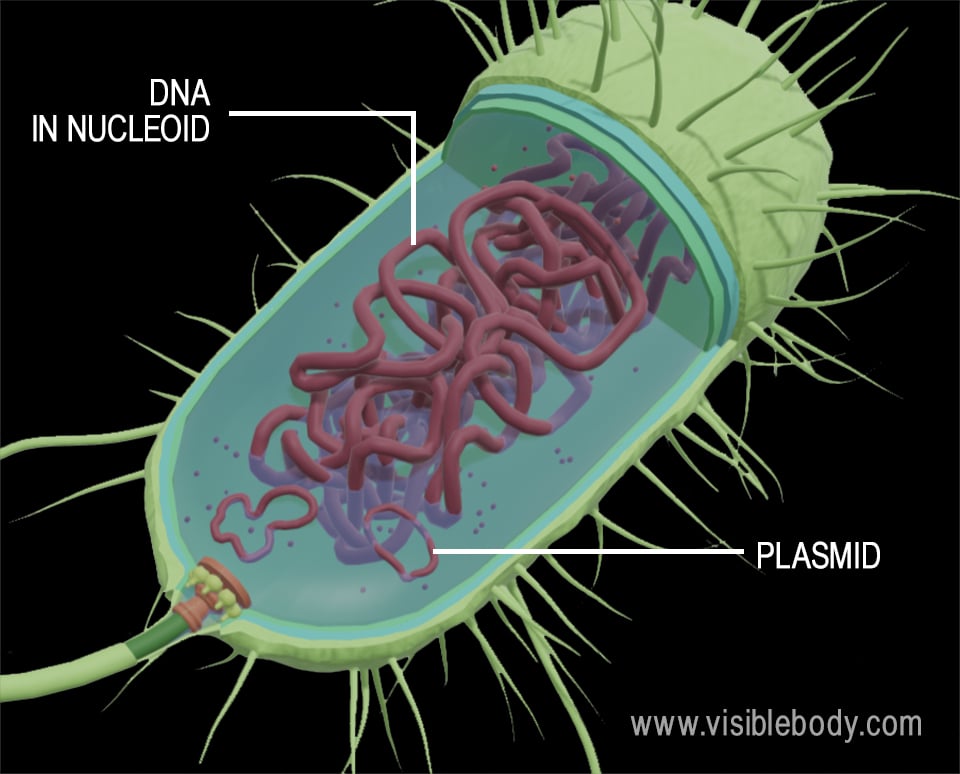Unlike eukaryotic cells, prokaryotic cells don’t have a membrane-bound nucleus. Instead, their genetic material can be found in a region of the cytoplasm called the nucleoid. A prokaryotic cell typically has only a single, coiled, circular chromosome. However, there are a few prokaryotes that have more than one—Vibrio cholerae, the bacterium that causes cholera, has two circular chromosomes.
Prokaryotic cells may have only one chromosome, but that one chromosome is a very long DNA molecule that must be condensed to fit inside a tiny space. In a eukaryotic cell, DNA wraps around clusters of histone proteins. However, most prokaryotic cells don’t use histones to help with DNA storage. (Some Archaea do, but they are the exception, rather than the rule.)
Like eukaryotic DNA, prokaryotic DNA undergoes supercoiling, but it is not wound around histone clusters first. Supercoiling uses the application of tension to twist a DNA molecule, so it wraps around itself, creating loops.
The folding of prokaryotic DNA is facilitated by nucleoid-associated proteins (NAPs) instead of histones. NAPs are proteins within the nucleoid that can bind to the DNA molecule, introducing bends and folds, and they are involved with processes such as DNA replication and transcription.
Most prokaryotic cells have just one chromosome, so they are classified as haploid cells (1n, without paired chromosomes). Even in Vibrio cholerae, which has two chromosomes, the chromosomes are unique from one another. That is, they are not a homologous pair, because they don’t contain the same genes in the same locations.
Many prokaryotes, such as bacteria, reproduce via binary fission. This is a method of asexual reproduction that is similar in its end result to mitosis—two daughter cells result, each with the same number of chromosomes as the parent cell. However, when bacteria undergo binary fission, no mitotic spindle forms. In addition, the replication of the prokaryotic cell’s chromosome can occur during the fission process.
Plasmids are small, circular DNA molecules that contain the cell’s nonessential genes. Although plasmids can occur in a variety of sizes (ranging from around a thousand base pairs to hundreds of thousands), they usually only have a small number of genes. Antibiotic resistance is a trait that is frequently attributed to genes on plasmids.

The genetic material of plasmids is separate from that of the cell’s main chromosome, and they can replicate independently of that chromosome. When a prokaryotic cell with a plasmid divides, the daughter cells each receive a copy of the plasmid, along with its regular chromosome.
Here’s how the characteristics of eukaryotic and prokaryotic chromosomes compare.
| Eukaryotic Chromosome | Prokaryotic Chromosome | |
|---|---|---|
| Shape | Linear | Circular |
| Size | Large | Small |
| Number | Multiple | Single |
| Location | Nucleus | Nucleoid (region in cytoplasm) |
| Storage proteins | Histones | Nucleoid-associated proteins |
“The Precarious Prokaryotic Chromosome” from the Journal of Bacteriology.
A video on DNA topology and supercoiling from the MITx Molecular Biology course.
“Nucleoid Associated Proteins: The Small Organizers That Help to Cope With Stress” from Frontiers in Microbiology.
An article from Scitable/Nature Education on genome packaging in prokaryotes.
An article from Khan Academy about binary fission in bacteria.
“The Vibrio cholerae genome contains two unique circular chromosomes,” from the Proceedings of the National Academy of Sciences.
Definitions of plasmids from Scitable and the National Human Genome Research Institute.
When you select "Subscribe" you will start receiving our email newsletter. Use the links at the bottom of any email to manage the type of emails you receive or to unsubscribe. See our privacy policy for additional details.